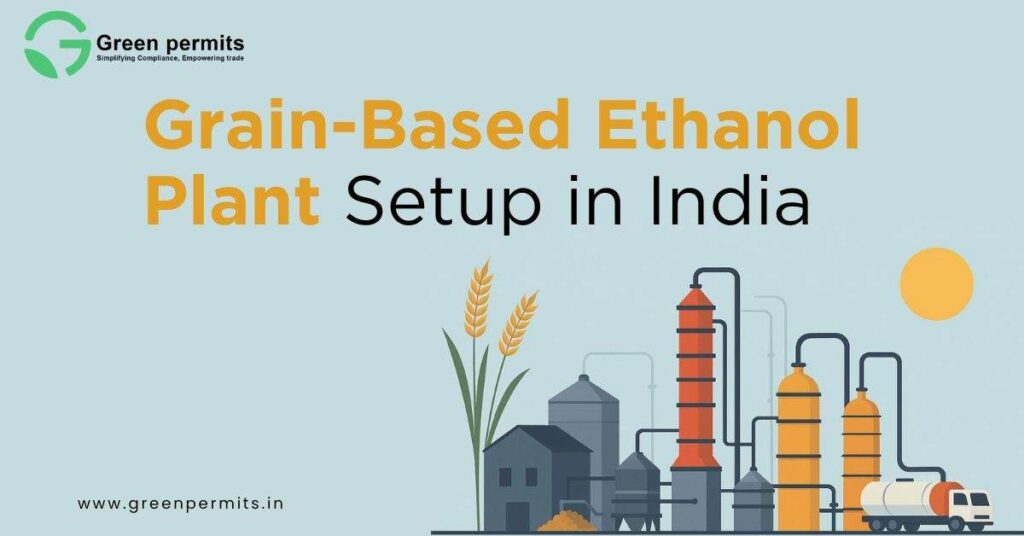- Home
- About Us
- Services
- Blogs
- Be our Partner
- Testimonials
- Contact Us
- Home
- About Us
- Services
- Blogs
- Be our Partner
- Testimonials
- Contact Us
India has advanced its ethanol program, setting the ambitious goal of achieving 20% blending by 2025. In FY 2023–24, OMCs procured over 600 crore litres of ethanol, cutting crude oil imports and creating new opportunities for farmers. With molasses-based plants nearing capacity, grain-based ethanol plants are emerging as the next growth engine.
This guide explains the setup process, approvals, costs, subsidies, and opportunities for businesses planning to enter the ethanol sector.

Grain ethanol plants use maize, broken rice, sorghum, or millets as feedstock to produce high-purity ethanol. Unlike molasses plants, they can run year-round, ensuring a consistent supply chain. Their by-products like DDGS and CO₂ also add revenue streams.
Takeaway: Grain ethanol offers reliability, scalability, and profitability compared to molasses-based production.
The government is strongly backing ethanol as part of India’s energy security strategy. Grain ethanol is central to meeting blending targets and reducing oil import bills.
Takeaway: With assured demand from OMCs and policy incentives, grain ethanol plants are well-positioned for rapid growth.
Setting up a grain-based ethanol plant requires careful planning and multiple regulatory approvals. Businesses must balance feasibility studies, compliance, and technology choices.
Takeaway: A detailed project report (DPR) with compliance built-in helps reduce delays and ensures easier financing.
Building a grain ethanol plant involves significant upfront costs, but government schemes and OMC contracts reduce the financial risk.
Takeaway: With assured ethanol offtake and loan subsidies, investors typically recover their investment in 4–5 years.
The grain ethanol process converts starch-rich grains into fuel-grade ethanol through fermentation and purification. Its integrated by-product recovery systems make plants more profitable.
Takeaway: By-products contribute up to 25% of revenue, boosting overall project viability.
Ethanol plants must comply with strict environmental and quality standards to operate legally. A structured approach to licensing ensures smooth project execution.
Takeaway: Regulatory compliance is multi-layered, but with proper planning, approvals can be secured within project timelines.
Government subsidies make ethanol plants one of the most attractive investments in India’s renewable energy sector.
Takeaway: Financial incentives significantly reduce the risk for new entrants in the ethanol sector.
Grain ethanol has applications that extend beyond fuel blending. Investors can tap into multiple markets, from domestic blending demand to global trade.
Takeaway: Grain ethanol is not only a compliance-driven business but also a gateway to green growth opportunities.
Navigating compliance, financing, and plant setup can be complex. Businesses benefit from expert guidance to avoid costly delays.
Takeaway: With Green Permits, businesses can focus on operations while compliance and approvals are managed seamlessly.
Many businesses are new to ethanol and face recurring questions. Below are some of the most common queries.
A 100 KLPD plant costs ₹120–₹160 crore.
Maize, broken rice, and sorghum are widely used.
Interest subvention, state rebates, and VGF support.
CTE, CTO, MoEFCC clearance, BIS, Excise, and PESO approvals.
Typically 18–24 months from DPR to commissioning.
Takeaway: With proper planning, most approvals and setup challenges can be managed within two years.
If you are planning to set up a grain-based ethanol plant in India, now is the right time to act. Green Permits can help you with everything from DPR to approvals and OMC tie-ups.
Call: +91-78350 06182
Email: wecare@greenpermits.in
Website: www.greenpermits.in
Book Consultation for Ethanol Plant Setup and move your project forward with confidence.